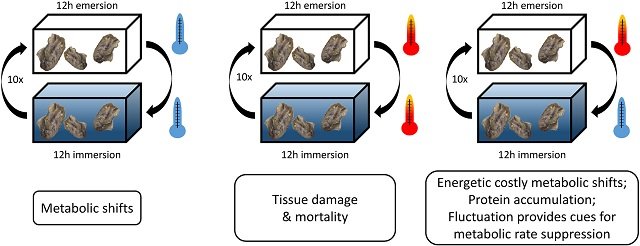
Living in coastal regions presents one of the most significant challenges for sessile benthic species due to the ever-changing environmental conditions. One of the sources of variability is the natural tidal cycle.
The constantly shifting environment of tidal coastal zones subjects the Pacific oyster Crassostrea (Magallana) gigas to physiological challenges that can be quite daunting. Among the most critical factors are fluctuations in oxygen levels and temperature, which can have profound effects on the bioenergetics and metabolic balance of these coastal inhabitants.
Researchers from the University of Rostock and the Leibniz Institute for Baltic Sea Research (IOW) sought to delve into the complexities of this struggle by investigating the combined effects of intermittent hypoxia and different temperature regimes in the Pacific oyster, Crassostrea (Magallana) gigas.
The Enigma of Coastal Tides
Coastal tides are dynamic ecosystems where the ebb and flow of tides expose organisms to an ever-changing environment. One of the significant challenges for sessile creatures like the Pacific oyster is their limited mobility. Unlike fish or other mobile organisms, oysters cannot escape unfavorable conditions. This incapacity makes them highly susceptible to fluctuations in oxygen levels and temperature.
Oxygen is essential for the survival of most marine organisms, including oysters. When oxygen levels drop, as they often do in tidal zones, it can have severe consequences. Temperature is another critical factor, as it influences metabolic processes and the overall well-being of these creatures. However, it is the combined effect of these two variables that remains a mystery until now.
Investigating the Pacific Oyster’s Response
In the study, researchers aimed to unravel the impact of intermittent hypoxia (periods of low oxygen alternating with normal oxygen levels) along with different temperature conditions on the Pacific oyster, Crassostrea gigas. Three distinct temperature regimes were tested: normal (15°C), elevated (30°C), and fluctuating (15°C water/30°C air).
Fluctuating Temperature: Energetic Challenges
The researchers found that fluctuating temperatures posed a significant challenge to the Pacific oyster. In response to these conditions, the oysters had to undergo metabolic rearrangements, which were not without cost. The energy expended to adapt to these fluctuations came at the expense of other essential processes, affecting their overall well-being.
Furthermore, the fluctuating temperature conditions led to the accumulation of proteins in the oyster tissues, suggesting that the oysters were working hard to cope with this challenging environment.
Elevated Temperature: A Deadly Threat
Elevated temperatures, reaching 30°C, proved to be a deadly challenge for these oysters. Approximately 60% of the oysters subjected to this condition did not survive, succumbing to the intense heat. For the survivors, the elevated temperature caused oxidative damage.
Oxidative stress occurs when there is an imbalance between reactive oxygen species (ROS) and the body’s ability to detoxify them. In the case of the oysters, this imbalance led to cellular damage and dysfunction.
Normal Temperature: A Relative Haven
Surprisingly, the normal temperature condition at 15°C did not have major negative effects on the oysters. However, this doesn’t mean the oysters were unaffected. Even at a seemingly benign temperature, the Pacific oysters exhibited metabolic shifts, highlighting the adaptability and resilience of these creatures.
Plasticity in Response to Environmental Stress
This study demonstrates the remarkable plasticity of oyster metabolism in response to the challenges posed by fluctuations in oxygen levels and temperature. Oysters showed the ability to adapt and adjust their metabolism to cope with intermittent hypoxia and temperature fluctuations. It’s essential to recognize that these adaptive responses come at an energetic cost.
Furthermore, the research highlights the critical role of ambient temperature in mediating the oyster’s metabolic adjustments when facing oxygen deficiency. Temperature is not just a passive factor but actively modulates how these creatures respond to environmental stress.
The Limits of Adaptive Metabolic Plasticity
Perhaps the most significant finding from this study is that when oysters are exposed to a constant, elevated temperature and intermittent hypoxia, their metabolic plasticity has its limits. This indicates that even the most adaptable creatures have their breaking point. Understanding these limits is crucial for predicting the impact of climate change and other environmental stressors on coastal ecosystems.
In conclusion, “Our present study demonstrated that intermittent hypoxia combined with fluctuating temperature induced metabolic changes in C. gigas, which were accompanied by energy reserve depletion,” conclude the researchers.
The study on the Pacific oyster, Crassostrea gigas, provides valuable insights into the complex interplay between oxygen fluctuations and temperature changes in tidal coastal ecosystems. It underscores the remarkable adaptability of oysters and their capacity to respond to challenging environmental conditions. However, it also serves as a reminder that there are limits to this adaptability, and the delicate balance of life on tidal coasts remains vulnerable to the ongoing changes in our planet’s climate.
Contact
Inna M. Sokolova
Department of Marine Biology
Institute for Biological Sciences, University of Rostock
Albert-Einstein-Str.3, 18059, Rostock, Germany.
Email: Inna.Sokolova@uni-rostock.de
Reference
Torben Bruhns, Stefan Timm, Nina Feußner, Sonja Engelhaupt, Matthias Labrenz, Mathias Wegner, Inna M. Sokolova. 2023. Combined effects of temperature and emersion-immersion cycles on metabolism and bioenergetics of the Pacific oyster Crassostrea (Magallana) gigas, Marine Environmental Research, 2023, 106231, ISSN 0141-1136, https://doi.org/10.1016/j.marenvres.2023.106231.

